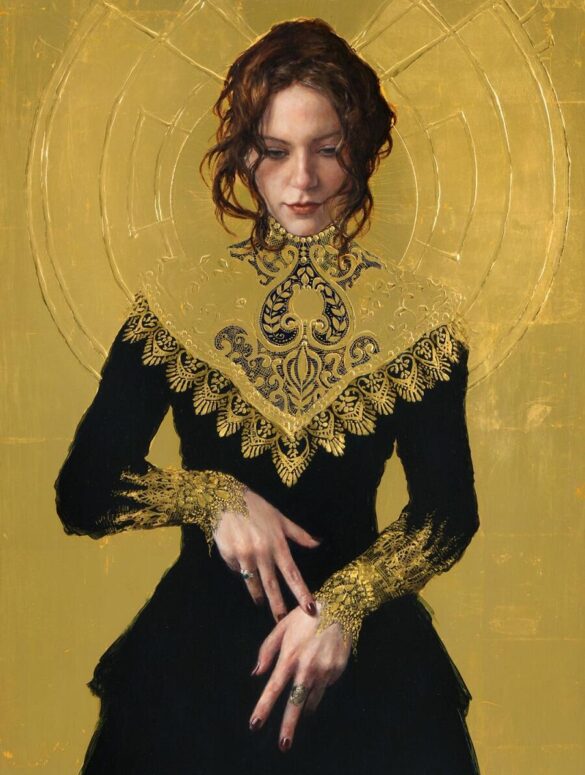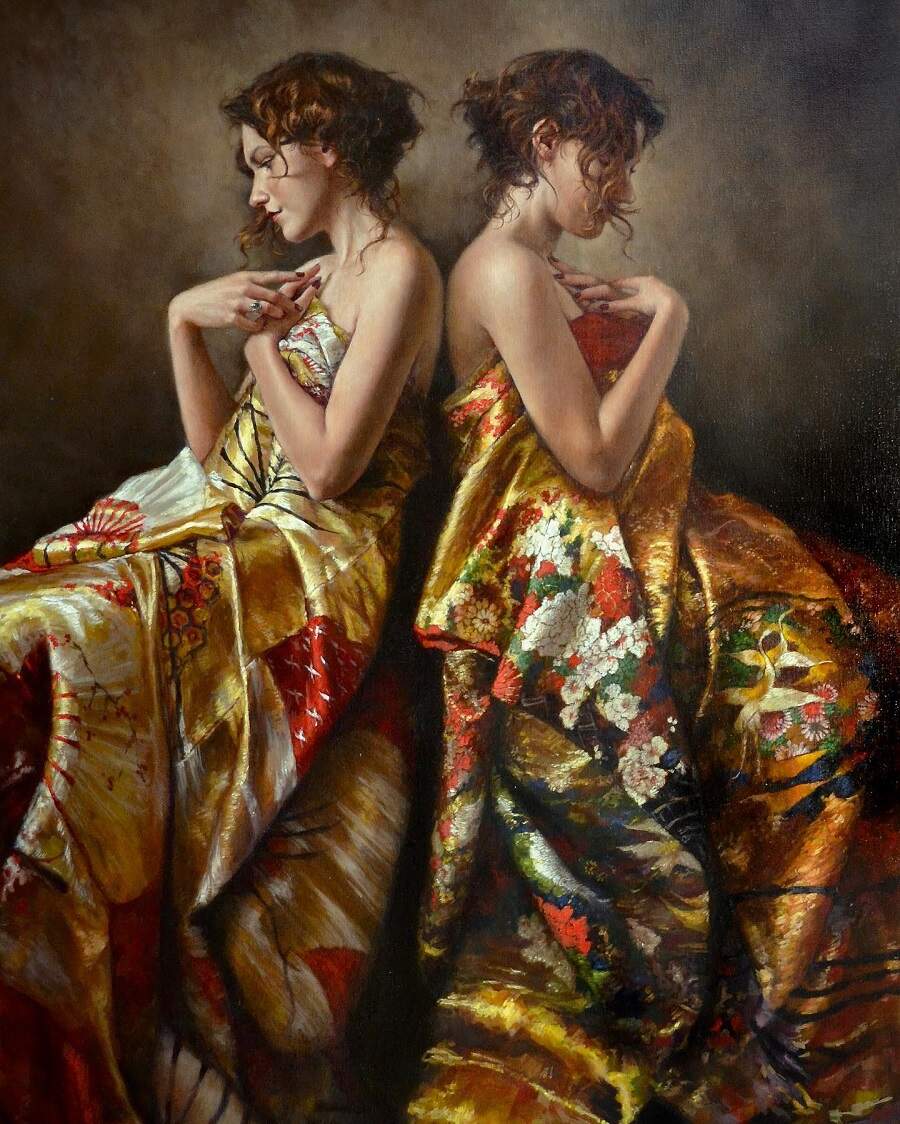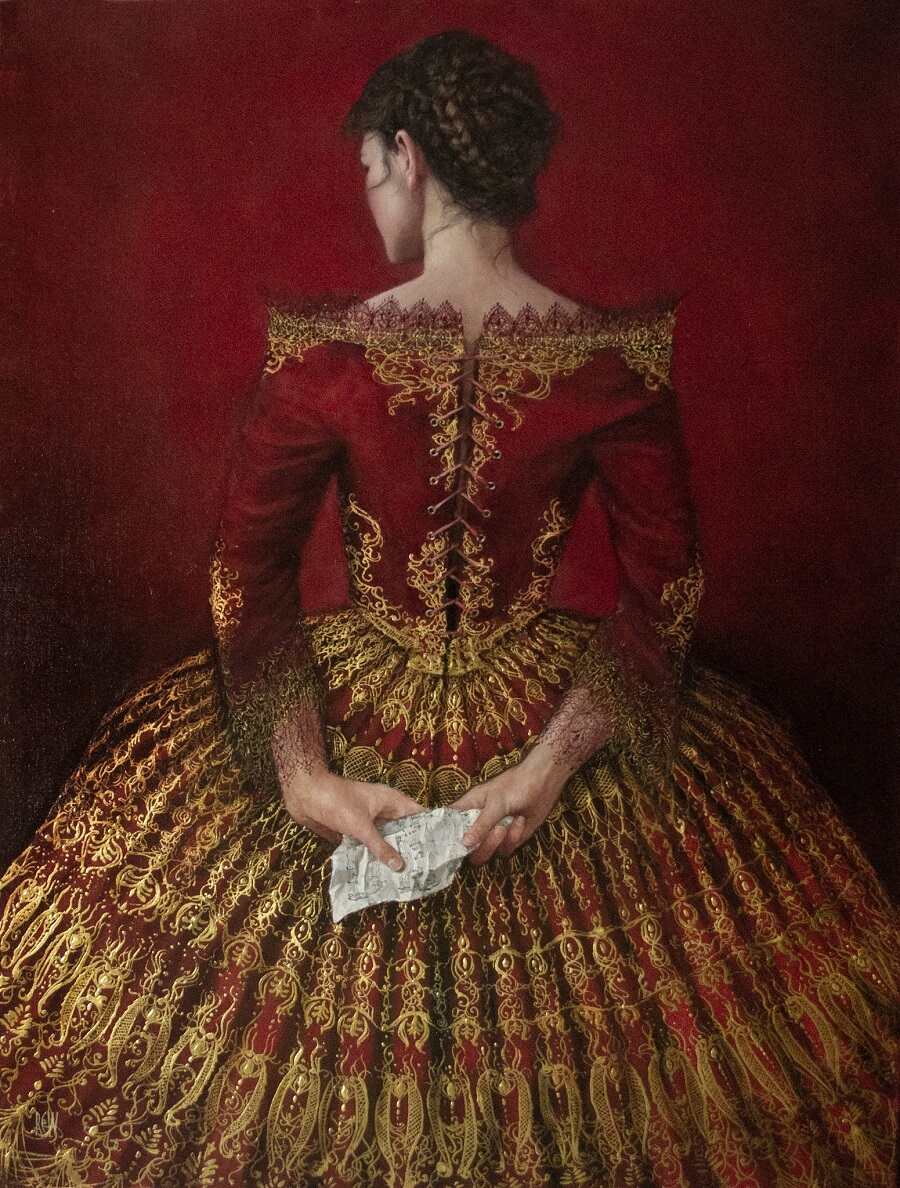Exclusive Interview with Stephanie Rew, Winner of the People’s Choice Award 2021 Beautiful Bizarre Art Prize. Interview conducted by Addison Devereux.
Stephanie Rew says she has always been creative. As a child, she was constantly drawing or creating. Of her family, she was the only one blessed with an artistic ability so almost everything she created was museum worthy in their eyes. Though she did not know it then, the Scottish-based painter developed a sense of fearlessness from the praise of her parents and grandparents. She was able to appreciate the visual beauty of the works she created, a trait she was taught by her mother which helped make her decision to make art a career an unconscious one.


I tend to work on 5 or 6 paintings at the same time, this give the series of works a harmony. I can work on one while another is drying so it has a practical benefit, but I work this way mainly because as I like to fully explore the concept by painting multiples.
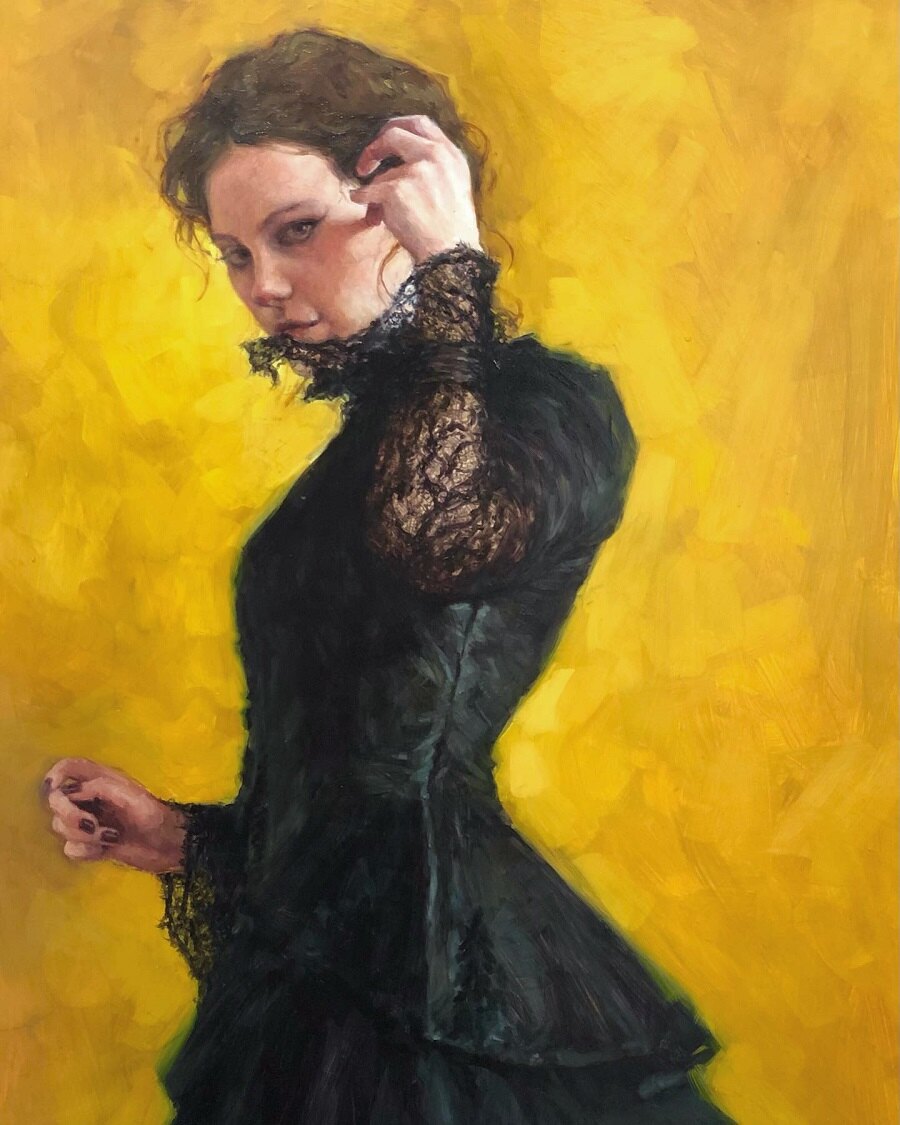
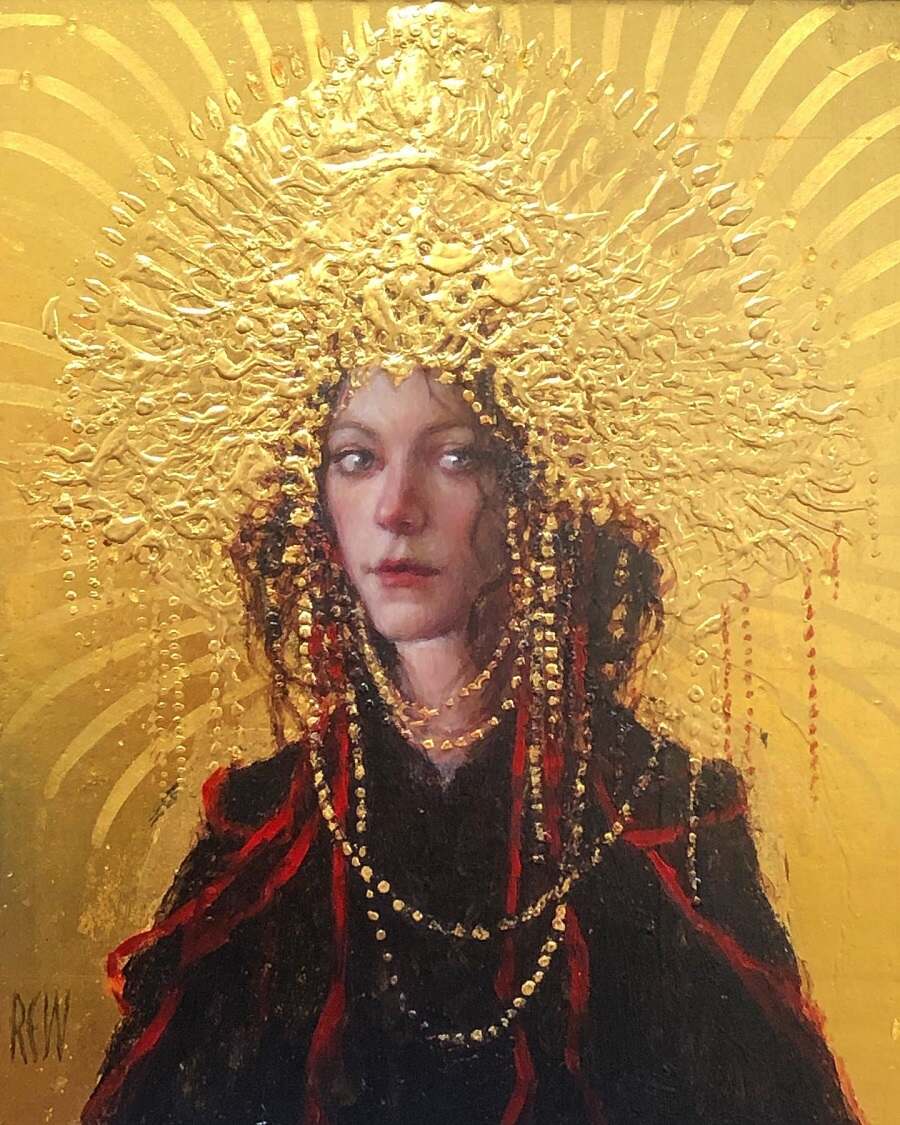
Exclusive Interview with Stephanie Rew
What encouraged or inspired you to pursue visual arts?
I have always been creative – as a child I was always drawing or making things. I was the only one of my family with an artistic side, which meant that, to my parents and grandparents, everything I did was seen as amazing! I was always encouraged and praised and this, I realise now, made me fearless. I didn’t worry about getting things wrong at this early stage (that came later). My mum may have not been able to draw but she has terrific taste in general so I was taught by her to appreciate the visual beauty in things. My decision to make art my career was not a conscious one– it’s just a thing I’ve always loved doing and find it impossible to stop.
What are some of the most important things you have learned from your time at Duncan of Jordanstone College of Art?
I learned to treat painting as a 9 to 5 profession. They taught me that you had to put in the hours to get better. Also being around so many other, far more talented people, made me learn that, rather than being intimidated by it, I had to raise my bar and get better. When I was at college, in the early 90’s, figurative art was not popular and a more conceptual approach to teaching art was preferred. This left me a little out at sea, as all I wanted to do was paint the figure and I naively expected to be taught how to paint like Rembrandt! I decided to dig my heels in though and stick with it, realising I was a lot more determined that I thought I was. I came out of college a bit deflated with an average degree, which made it impossible to take my studies to a Masters level. This in hindsight was the best thing that could have happened to me as I started to teach myself the technique I was lacking and approached the commercial gallery world at an earlier stage in my career.
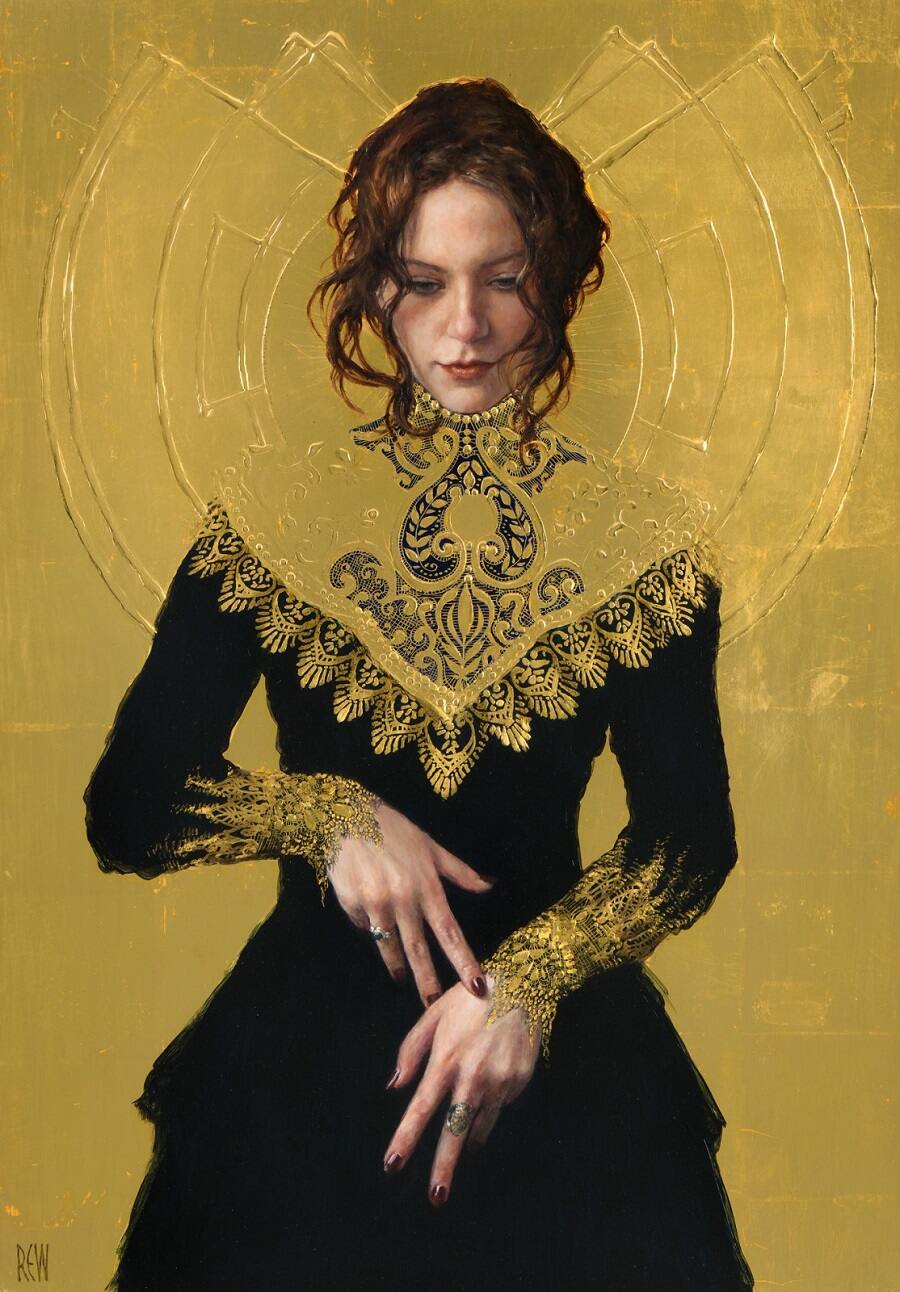

I am interested in expressing the human condition in my work and for me the portrait is the best way to do this.
Tell me about your artistic process. What sort of headspace do you find is the most inspiring for you? Do you have any superstitions regarding new pieces?
I tend to work on 5 or 6 paintings at the same time, this give the series of works a harmony. I can work on one while another is drying so it has a practical benefit, but I work this way mainly because as I like to fully explore the concept by painting multiples. It gives the body of work a cohesion. I don’t do sketches or colour studies first. I like to go straight into the painting stage as quickly as possible. I may do drawings of the same pose but these drawings tend to be finished works in their own right and not preparation or supporting sketches to the painting. I feel if I spend a lot of time doing studies, I fear the final work will lose its energy and magic. I always have a clear idea in my head of what I am going to do each day and I’ve been known to walk into my studio in the morning, and start painting with my coat on and my bag still on my shoulder. I work quickly and when I approach the easel, I hit the ground running so to speak.
You appear to have an affinity towards portrait pieces, but you also do amazing things with landscapes. Do you have any interest in expanding more on these?
I love painting landscapes for my own enjoyment mainly. I don’t paint them very often but I find that I do when I am needing a break from the other work. The nature of figurative painting means you have to achieve a certain accuracy with scale, tone, colour etc. to make it believable. If you get it wrong everyone knows about it, but with a landscape it is much more free; I can relax and paint a place from my imagination without any pressure. It’s like art therapy for me so the works are quite personal. I can’t see myself ever turning away completely from the figure towards the landscape as I feel a face or a gesture can convey so much more emotions than a landscape. I am interested in expressing the human condition in my work and for me the portrait is the best way to do this.


Which of your various mediums do you like working with the most? It seems that when you work with
Kimonos – there tends to be a lot of gold used, which pairs very well with your various mediums. I love working in oil paint, and recently I enjoy combining traditional oil painted portraits with gold leaf. I started working with gold a few years ago – but in the last year or so, it has become a very important part of my creative process. I use traditional early renaissance technique of water gilding to achieve the texture and pattern in this beautiful medium. There is so much you can do with it and the decorative affects you can achieve are endless so I can’t see myself getting bored with it for a while. And I bore quickly.
I have always been a frustrated sculptor, I wanted to study it at college but found that I was better at paintings and loved colour too much to give it up. The practical aspect of working with gesso…building up low relief pattern, engraving and hammering and the polishing and burnishing of the gold satisfies that side of my personality. Kimonos have been an inspiration and were what got me incorporating colour and pattern into my work. Drapery and textiles are a joy to paint and the kimono is a work of art in its own right – every design is unique, so for me its very much like painting a portrait. Recently the shapes and patterns of historical costume have become a new passion for me. I find they help to tell a story and give my figures a place both in this time but also from another.
In my multiple figure paintings, I look to convey the empathy, support and love that can be shown by gesture alone – the silent conversations we all have with our mothers, friends, sisters and daughters.
Tell me about your decisions to paint multiple women in your works. Since so many of your pieces focus on the designs of the costume and the solo model, the pieces featuring more than one woman really stand out.
I am fascinated by the way people communicate, and as woman I see how females are so good at expressing themselves nonverbally. In my multiple figure paintings, I look to convey the empathy, support and love that can be shown by gesture alone – the silent conversations we all have with our mothers, friends, sisters and daughters.
You work with various sizes of canvas. Do you have a preference between working large or small?
I like working both large and small, with the gold panels it is very difficult to work big as the gesso would make more wooden panels warp if they are over a certain size. I’m currently trying to work that problem out as I would love to do some huge panels in this medium. Recently, I have been experimenting with gilding technique called sgraffito, which involves a very fine pattern being etched into egg tempera on gold leaf and this is work that suits the miniature format so I’m happy working at any scale.
Describe your art space.
I work in Coburg House Studios in the Leith area of Edinburgh. There are 70 artists, designers and makers in the building some sharing studio, some hotdesking. We are a close community and have open studio weekends, which helps to keep all the artists connected and working together. We even have Christmas parties, which as an self-employed artist is a total bonus. Being an artist can be a very solitary profession and it is easy to become isolated and lonely, so having a work place with other creatives is incredibly important to me. My studio is a place where I can keep all the things that I can’t have or won’t fit in my home – it is full costumes, kimonos, hats, antique frames, a chaise longue and other lovely looking things – it is a physical extension of my personality and I absolutely love it.
How long does an image usually take you to complete?
As I work on a few paintings at a time it is difficult to say how long a painting can take. A series of oil paintings can take 4 months but a series of gold panels can take a lot longer as the gessoing and gilding takes a long time to do properly. A drawing with gold leaf will take approx. 20-30 hours working time. My last solo show took the best part of 18 months to complete with 28 works included. The majority of my time is spent on conception, planning, finding models, arranging photos shoots, editing photographs, preparing substrates and generally problem solving and planning the work. The actual painting process is quite straight forward in comparison. There is no off button on an artist – we are always working!
I see my job as an artist is to uplift the viewer and make the world a more beautiful place, what influence that has in the wider art scene is probably minimal but if it connects to a few I’m satisfied with that.
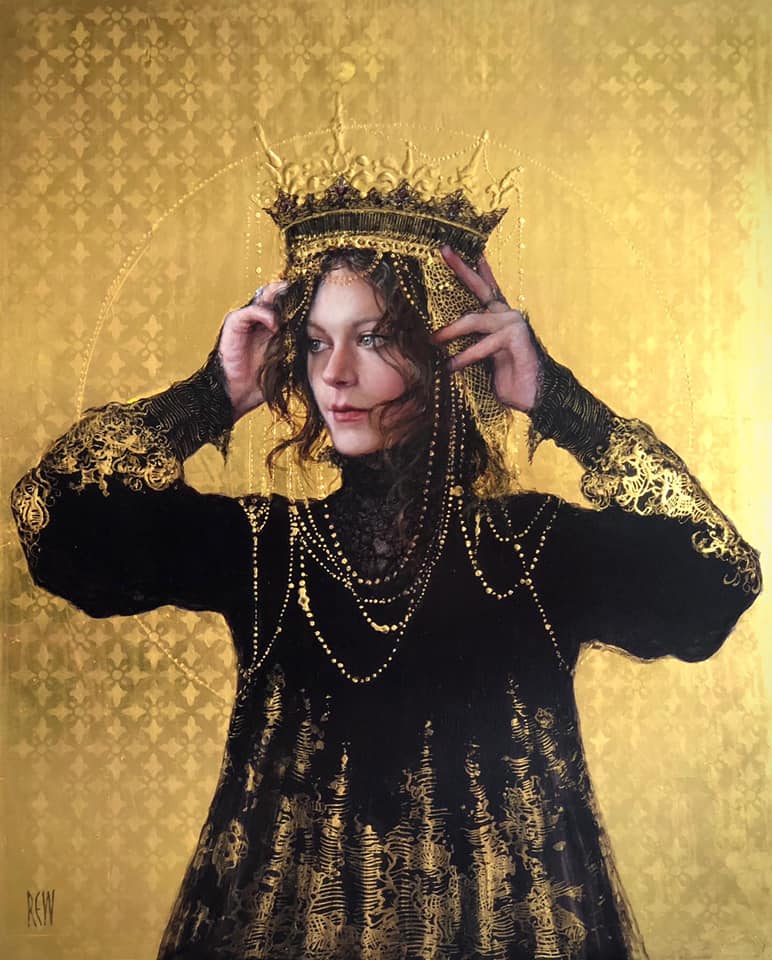

How did your interest in kimonos, and costumes in general, come about?
Most of the art I admire is from a previous time, be it the Victorian painters to Holbein’s Tudor portraits and Utamaro’s geishas…I’ve always looked to the past for inspiration. I wanted to incorporate pattern into my work after painting draped nudes for a long time, mainly in monochrome, and found a kimono on eBay. There was no going back after that. I found that a traditionally painted portrait could be brought to life with a graphic element and the kimono has both the design element as well as the timeless quality I look for in my art.
Who or what has been the single most important influence for your work today? Who are some of the other artists that have influenced you?
I love the drama of the baroque artists – especially Caravaggio and Artemisia Gentileschi. The decorative arts of the Secession artists such as Mucha and the Scottish Arts and crafts movement, naming Margaret McDonald and Phoebe Anna Traquair as two of the most inspirational, have a lasting influence on my work. I also love the photographers of the late 19thC, such as Margaret Cameron, and the tonalist photographers Steichen and Steiglitz also have a place in my heart. I went to college when Jenny Saville and Alison Watt hit the big time and I believe it was their success that made me believe that it was possible for me to be a successful figurative artist if I put the work in.
How do you see your work influencing the art scene on a wider scale?
I just don’t think about that kind of thing at all. I paint what makes me happy and I try to find beauty in all things. I see my job as an artist is to uplift the viewer and make the world a more beautiful place, what influence that has in the wider art scene is probably minimal but if it connects to a few I’m satisfied with that.
Do you have any interest in branching away from your mediums? With you interest in costumes, have you created any of your own textiles?
I would love to try sculpture. It’s a dream of mine to bring my figures into 3 dimensions. It’s a tall order though. Maybe one day.

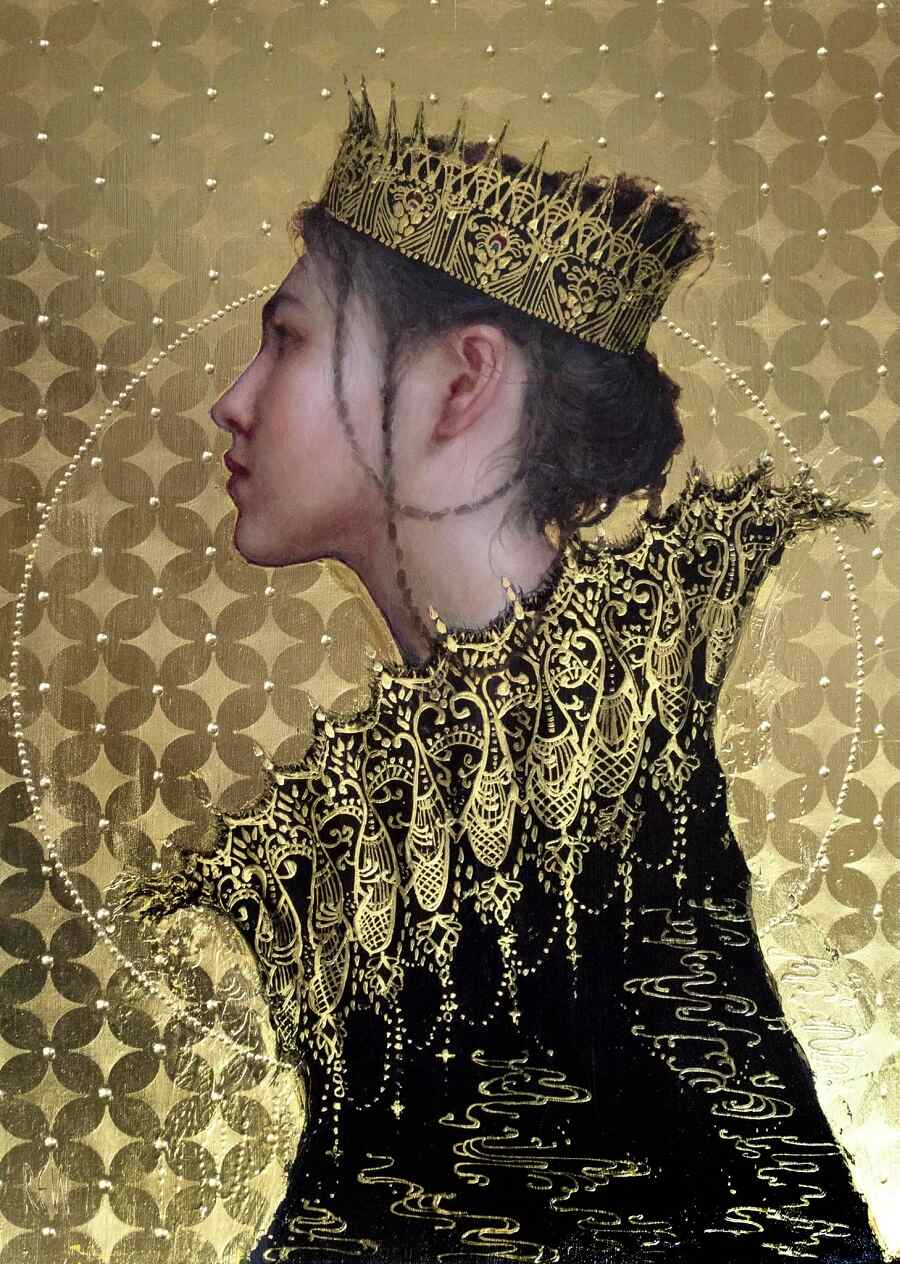
Tell me about your favourite piece.
My favourite piece is usually the most recent one! I guess this year (2021) the painting ‘Narcissus’ (below) would be that one. It was the painting that started the whole series of gold panels at the start of lockdown. It began as in idea I had when a studio friend gave me a lens from a binocular she had acquired. I had the idea to set it into a panel but didn’t know how I would do it and what the story of the piece would be. I had been working with glass gilding and thought about turning the lens into a tiny mirror by gilding them back. The idea of ‘Narcissus’ came from that. The idea of having the viewer looking at the painting and seeing yourself looking back out in the reflection appealed to me. I gilded and painting the panel then had the trauma if having to drill a hole into the middle of it to fit the lens into the wood. It was like conducting a tracheotomy on the painting as the lens was in the middle of her throat. It was one of the scariest things I have done as a painter, as I could have ruined months of work. It won the BBM People’s Choice Award so it ended up being worth the risk.
When you are not engaged in creating art, what sort of things hold your attention?
I like upcycling, diy and building things. Also gardening.

“Narcissus”
Oil, egg tempera, gold leaf and optical lens on panel, 40″ x 66″
